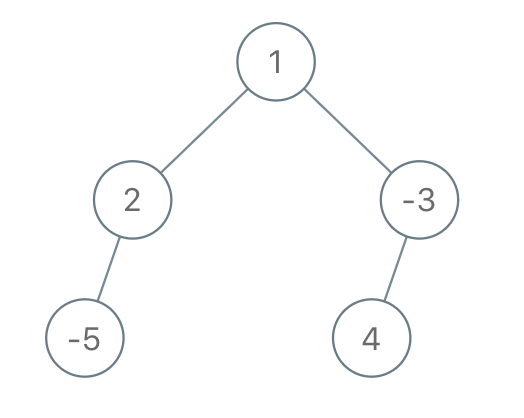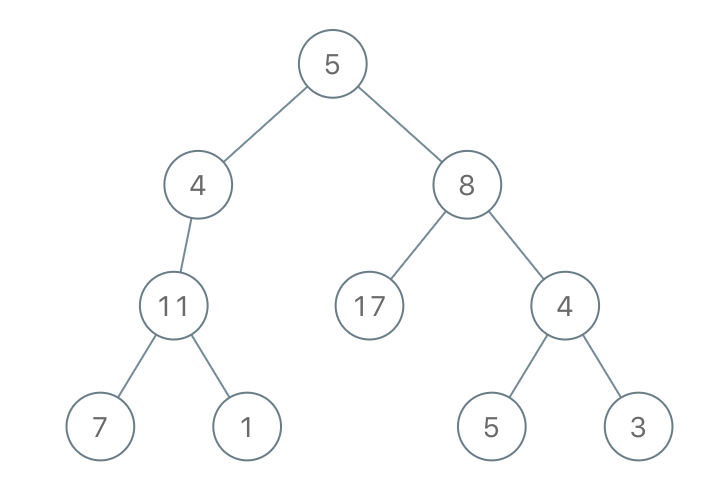给你二叉树的根节点 root 和一个整数 limit ,请你同时删除树中所有 不足节点 ,并返回最终二叉树的根节点。
假如通过节点 node 的每种可能的 “根-叶” 路径上值的总和全都小于给定的 limit,则该节点被称之为 不足节点 ,需要被删除。
叶子节点 ,就是没有子节点的节点。
示例 1:

**输入:** root = [1,2,3,4,-99,-99,7,8,9,-99,-99,12,13,-99,14], limit = 1
**输出:** [1,2,3,4,null,null,7,8,9,null,14]
示例 2:

**输入:** root = [5,4,8,11,null,17,4,7,1,null,null,5,3], limit = 22
**输出:** [5,4,8,11,null,17,4,7,null,null,null,5]
示例 3:

**输入:** root = [1,2,-3,-5,null,4,null], limit = -1
**输出:** [1,null,-3,4]
提示:
- 树中节点数目在范围
[1, 5000] 内
-105 <= Node.val <= 105-109 <= limit <= 109
方法一:深度优先搜索
思路与算法
根据题意可知「不足节点」的定义为:通过节点 node 的每种可能的「根-叶」路径上值的总和全都小于给定的 limit,则该节点被称之为「不足节点」。
按照上述定义可知:
- 假设节点 node 为根的子树中所有的叶子节点均为「不足节点」,则可以推断出 node 一定也为「不足节点」,即经过该节点所有“根-叶” 路径的总和都小于 limit,此时该节点需要删除;
- 假设节点 node 为根的子树中存在叶子节点不是「不足节点」,则可以推断出 node 一定也不是「不足节点」,因为此时一定存一条从根节点到叶子节点的路径和大于等于 limit,此时该节点需要保留。
根据上述的分析,我们用 checkSufficientLeaf}(\textit{node}) 来检测 node 节点为子树是否含有叶子节点不为「不足节点」,每次进行深度优先搜索时并传入当前的路径和 sum,每次检测过程如下:
- 如果当前节点 node 为叶子节点,则当前 “根-叶” 路径和为 sum 加上 node 节点的值,如果当前的路径和小于 limit,则该叶子 node 一定为「不足节点」,返回 false,否则该节点一定不为「不足节点」,返回 true;
- 依次检测 node 节点的左子树与右子树,如果当前节点 node 的左子树中的叶子节点均为「不足节点」,则左孩子需要删除,否则需要保留;如果当前节点 node 的右子树中的叶子节点均为「不足节点」,则右孩子需要删除,否则需要保留。如果当前子树中的所有叶子节点均为「不足节点」则当前节点需要删除,否则当前节点需要保留。
- 最终检测 root 的叶子节点是否均为「不足节点」,如果是则返回 null,否则返回 root。
代码
[sol1-C++]1
2
3
4
5
6
7
8
9
10
11
12
13
14
15
16
17
18
19
20
21
22
23
24
25
| class Solution {
public:
bool checkSufficientLeaf(TreeNode *node, int sum, int limit) {
if (!node) {
return false;
}
if (node->left == nullptr && node->right == nullptr) {
return node->val + sum >= limit;
}
bool haveSufficientLeft = checkSufficientLeaf(node->left, sum + node->val, limit);
bool haveSufficientRight = checkSufficientLeaf(node->right, sum + node->val, limit);
if (!haveSufficientLeft) {
node->left = nullptr;
}
if (!haveSufficientRight) {
node->right = nullptr;
}
return haveSufficientLeft || haveSufficientRight;
}
TreeNode* sufficientSubset(TreeNode* root, int limit) {
bool haveSufficient = checkSufficientLeaf(root, 0, limit);
return haveSufficient ? root : nullptr;
}
};
|
[sol1-Java]1
2
3
4
5
6
7
8
9
10
11
12
13
14
15
16
17
18
19
20
21
22
23
24
| class Solution {
public TreeNode sufficientSubset(TreeNode root, int limit) {
boolean haveSufficient = checkSufficientLeaf(root, 0, limit);
return haveSufficient ? root : null;
}
public boolean checkSufficientLeaf(TreeNode node, int sum, int limit) {
if (node == null) {
return false;
}
if (node.left == null && node.right == null) {
return node.val + sum >= limit;
}
boolean haveSufficientLeft = checkSufficientLeaf(node.left, sum + node.val, limit);
boolean haveSufficientRight = checkSufficientLeaf(node.right, sum + node.val, limit);
if (!haveSufficientLeft) {
node.left = null;
}
if (!haveSufficientRight) {
node.right = null;
}
return haveSufficientLeft || haveSufficientRight;
}
}
|
[sol1-Python3]1
2
3
4
5
6
7
8
9
10
11
12
13
14
15
16
| class Solution:
def sufficientSubset(self, root: Optional[TreeNode], limit: int) -> Optional[TreeNode]:
def checkSufficientLeaf(node, sum, limit):
if node == None:
return False
if node.left == None and node.right == None:
return node.val + sum >= limit
haveSufficientLeft = checkSufficientLeaf(node.left, sum + node.val, limit)
haveSufficientRight = checkSufficientLeaf(node.right, sum + node.val, limit)
if not haveSufficientLeft:
node.left = None
if not haveSufficientRight:
node.right = None
return haveSufficientLeft or haveSufficientRight
haveSufficient = checkSufficientLeaf(root, 0, limit)
return root if haveSufficient else None
|
[sol1-Go]1
2
3
4
5
6
7
8
9
10
11
12
13
14
15
16
17
18
19
20
21
22
23
24
25
26
| func sufficientSubset(root *TreeNode, limit int) *TreeNode {
haveSufficient := checkSufficientLeaf(root, 0, limit)
if haveSufficient {
return root
} else {
return nil
}
}
func checkSufficientLeaf(node *TreeNode, sum int, limit int) bool {
if node == nil {
return false
}
if node.Left == nil && node.Right == nil {
return node.Val+sum >= limit
}
haveSufficientLeft := checkSufficientLeaf(node.Left, sum+node.Val, limit)
haveSufficientRight := checkSufficientLeaf(node.Right, sum+node.Val, limit)
if !haveSufficientLeft {
node.Left = nil
}
if !haveSufficientRight {
node.Right = nil
}
return haveSufficientLeft || haveSufficientRight
}
|
[sol1-JavaScript]1
2
3
4
5
6
7
8
9
10
11
12
13
14
15
16
17
18
19
20
21
22
| var sufficientSubset = function(root, limit) {
const haveSufficient = checkSufficientLeaf(root, 0, limit);
return haveSufficient ? root : null;
};
var checkSufficientLeaf = function(node, sum, limit) {
if (node == null) {
return false;
}
if (node.left == null && node.right == null) {
return node.val + sum >= limit;
}
const haveSufficientLeft = checkSufficientLeaf(node.left, sum + node.val, limit);
const haveSufficientRight = checkSufficientLeaf(node.right, sum + node.val, limit);
if (!haveSufficientLeft) {
node.left = null;
}
if (!haveSufficientRight) {
node.right = null;
}
return haveSufficientLeft || haveSufficientRight;
};
|
[sol1-C#]1
2
3
4
5
6
7
8
9
10
11
12
13
14
15
16
17
18
19
20
21
22
23
24
| public class Solution {
public TreeNode SufficientSubset(TreeNode root, int limit) {
bool haveSufficient = CheckSufficientLeaf(root, 0, limit);
return haveSufficient ? root : null;
}
public bool CheckSufficientLeaf(TreeNode node, int sum, int limit) {
if (node == null) {
return false;
}
if (node.left == null && node.right == null) {
return node.val + sum >= limit;
}
bool haveSufficientLeft = CheckSufficientLeaf(node.left, sum + node.val, limit);
bool haveSufficientRight = CheckSufficientLeaf(node.right, sum + node.val, limit);
if (!haveSufficientLeft) {
node.left = null;
}
if (!haveSufficientRight) {
node.right = null;
}
return haveSufficientLeft || haveSufficientRight;
}
}
|
[sol1-C]1
2
3
4
5
6
7
8
9
10
11
12
13
14
15
16
17
18
19
20
21
22
| bool checkSufficientLeaf(struct TreeNode *node, int sum, int limit) {
if (!node) {
return false;
}
if (node->left == NULL && node->right == NULL) {
return node->val + sum >= limit;
}
bool haveSufficientLeft = checkSufficientLeaf(node->left, sum + node->val, limit);
bool haveSufficientRight = checkSufficientLeaf(node->right, sum + node->val, limit);
if (!haveSufficientLeft) {
node->left = NULL;
}
if (!haveSufficientRight) {
node->right = NULL;
}
return haveSufficientLeft || haveSufficientRight;
}
struct TreeNode* sufficientSubset(struct TreeNode* root, int limit){
bool haveSufficient = checkSufficientLeaf(root, 0, limit);
return haveSufficient ? root : NULL;
}
|
复杂度分析

